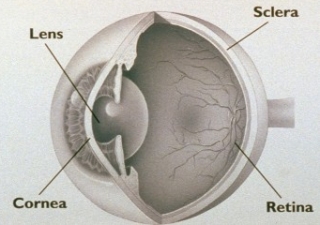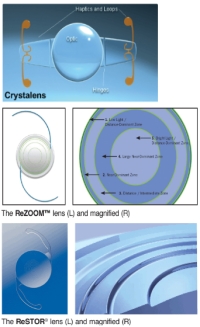Cataracts & Cataract Surgery
What is a cataract?
Inside the eye, directly behind the pupil is your natural lens. At birth, this lens is clear. As you grow older, due to years of sun exposure and metabolism, the lens starts to turn cloudy and begins to take on a yellowish hue. A cataract is the term we use for a lens that has begun this process. It is a normal structure and a normal part of the aging process.
How do cataracts affect my vision?
As cataracts develop, your vision becomes blurry due to the fact that light is no longer clearly focused on to the back of the eye (retina). You may begin to notice that street signs are harder to see along with reading, even with glasses. In addition, because the cloudy cataract tends to scatter light rather than focus it, glare in bright sunlight and haloes around lights at night can be a significant problem.

If I have cataracts, how can I improve my vision?
A new pair of glasses with an updated prescription may help in the early stages. Once the cataract has progressed to the point that glasses no longer help, surgery to remove the cataracts may be an option.
How are the cataracts removed?
Cataracts can only be removed through surgery. A small incision is made into the cornea to allow access to the cataract. The cataract is then broken into small pieces and removed through a process called phacoemulsification. Once the entire cataract is removed, an artificial lens is implanted into the eye to restore vision.

What is the recovery time after surgery?
The surgery itself is done under local anesthesia with you awake, but sedated, and takes approximately 30-45 minutes. Most patients go home with just a pair of dark glasses on, although some patients will go home with a patch. For the first week, you should refrain from heavy lifting and wearing eye makeup. All patients will need to have someone drive them on the day of surgery, but may resume driving the next day. After the one-week visit, you may resume your normal activities.
Will I need glasses after surgery?
The invention of implantable lenses in the eye in the 1950s and their subsequent widespread use in the 1980s drastically improved the outcomes of cataract surgery. Refinements in intraocular lens (IOL) technology have continued over the years, resulting in a variety of lenses that may be an option for you. Any lens you have implanted will give you excellent postoperative vision with a good pair of glasses. The main difference between the various lenses is what you are able to see without glasses.
Intraocular Lens Options
Standard Monofocal Intraocular Lenses are currently the most commonly implanted lenses. With a monofocal lens, you can have good uncorrected distance vision OR good near vision, but not both. Most patients choose to see clearly at distance and then wear over-the-counter reading glasses to see up close. Some patients who are nearsighted choose to remain nearsighted so that they can read without their glasses, in which case, they require glasses to see clearly at distance.
For patients with astigmatism (corneal distortion), Limbal Relaxing Incisions (LRIs) are used to reduce the amount of astigmatism after surgery. These are extra partial-depth incisions made into the cornea to relax corneal curvature in the steep axis.
For patients who desire less dependence on glasses, Premium Intraocular Lenses may be an option, although are generally considered cosmetic under most insurance plans:
- Astigmatism-Correcting Intraocular Lenses (Monofocal Toric Lenses) are specially designed to treat higher levels of astigmatism that are not otherwise treated by conventional lenses. For patients with significant astigmatism, these lenses may give the best uncorrected vision following surgery.
-

Presbyopia-Correcting Intraocular Lenses are designed to provide both distance and near vision. Two main types are currently available. Pseudo-accommodating lenses (Crystalens) are single-vision lenses that move inside the eye. Multifocal lenses (ReSTOR, ReZOOM, Technis) are stationary lenses that have several focal ranges rather than a single focal point. 85% of patients who have these lenses implanted in both eyes never wear glasses again. Some patients still require glasses for certain tasks like night-driving or computer use. Since these lenses do not correct for astigmatism, some patients require LRIs at the time of surgery or even a LASIK treatment (Laser Vision Correction) 3-6 months after surgery. Vision with these lenses improves over time, and it can take up to 6 months for best results.
A landmark decision by Medicare in May 2005 allows us to offer Premium Lenses to Medicare patients, even though they are not covered under the Medicare program. Generally, Medicare will cover the cost of the surgery and the cost difference for the Premium Lens will be billed to the patient.
There may be reasons why one IOL is better suited for you over another. During your preoperative examination, we will discuss which IOL is right for you.

